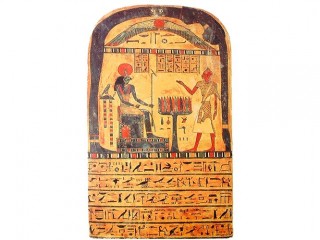
King Piankhi biography
Date of birth : -
Date of death : -
Birthplace :
Nationality : Nubian
Category : Historian personalities
Last modified : 2011-10-11
Credited as : Nubian Kingdom, Jebel Barkal,
The Nubian king Piankhi (reigned ca. 741-ca. 712 B.C.) began the conquest of Lower Egypt which resulted in the establishment of the Twenty-fifth, or "Ethiopian, " Dynasty of pharaohs. This was one of the few times in African history when a state from
the interior of the continent played a role in the politics of the Mediterranean.
Piankhi was the hereditary ruler of the kingdom of Cush on the Upper Nile in what is now the northern Sudan. About 741 B.C. he succeeded his father, Kashta, who seems to have founded this Nubian Kingdom. By this time Lower Egypt had been in full decline for almost half a millennium. The Egyptian state was torn by internal power struggles among petty rulers, so the situation was ripe for a strong invader to take over. Piankhi moved steadily down the Nile, conquering towns one by one. By 721 B.C. he was in possession of Heracleopolis, and finally he captured Heliopolis in the Delta.
At this point Piankhi regarded the conquest of Egypt as complete, and he returned home to his Cushite capital in Napata after placing the Egyptian rulers in tributary status. He was received in Napata with much acclaim for having humiliated the former Egyptian overlords of Nubia, but the tributary states which he left soon fell under the sway of a local ruler named Tefnakht, who reasserted Egyptian independence.
A great deal is known about the details of Piankhi's campaign because he built a huge stele in Amon with a lengthy inscription. This account is regarded as unusually rational and lively by modern Egyptologists.
Just like the Nubian rulers who followed him, Piankhi was culturally very conservative, and he sought to strengthen some of the institutions which were undergoing decline in Egypt. In the brief time he was in Lower Egypt, he oversaw the restoration of some crumbling temples. Upon his return to Cush he introduced the Egyptian custom of building pyramids for royal mausoleums, and he had a great pyramid built for himself in Kuru, south of Napata on the Nile. He rebuilt the temple at Jebel Barkal and also built a number of other temples in the Egyptian style.
Curiously, all the Egyptian sources dwell on Piankhi's love of fast horses. He instituted the practice of decorating teams of horses to pull royal chariots, and the remains of a team of horses were found in his tomb at Kuru.
There is no biography of Piankhi, but considerable detail on his conquest of Egypt is in the translation of his inscription at Amon in E.A. Wallis Budge, Books on Egypt and Chaldaea: Egyptian Literature, vol. 2: Annals of Nubian Kings (1912). An excellent, brief discussion of the relationship between ancient Egypt and the Sudan by A. Arkell is in Roland Oliver, The Dawn of African History (1961). Arkell's A History of the Sudan (1961) is also very useful. Considerable attention is given to Piankhi and the "Ethiopian" pharaohs in James Henry Breasted's classic A History of Egypt (1905; 2d ed. 1909). □
















